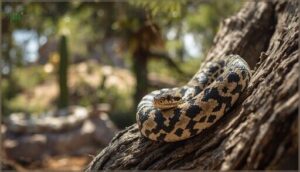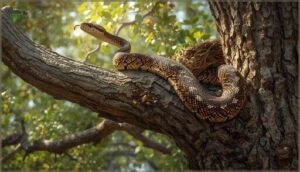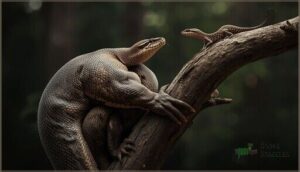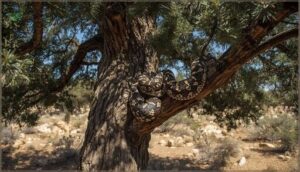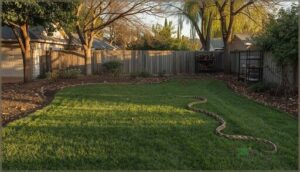This site is supported by our readers. We may earn a commission, at no cost to you, if you purchase through links.
Most hikers scan the ground for rattlesnakes, but a timber rattlesnake photographed 80 feet up in a Pennsylvania oak tree proves that danger doesn’t always slither at ankle level. Yes, rattlesnakes can and do climb trees, though it’s not their preferred mode of travel.
They’re surprisingly capable climbers when motivated by hunger, predators, or the need to regulate their body temperature. Younger, lighter snakes tend to climb more frequently, using a technique called concertina locomotion to inch their way up rough bark. While species like the western diamondback, black-tailed, and timber rattlesnake have all been documented in trees, you’re still far more likely to encounter one on solid ground.
Understanding when and why these venomous serpents take to the branches helps you stay safe in rattlesnake country, whether you’re hiking desert trails or managing your backyard in snake-prone regions.
Table Of Contents
- Key Takeaways
- Do Rattlesnakes Climb Trees?
- Which Rattlesnake Species Climb Trees?
- Reasons Rattlesnakes Climb Trees
- How Rattlesnakes Climb Trees
- Typical Heights Rattlesnakes Reach in Trees
- Surfaces Rattlesnakes Can and Cannot Climb
- Safety Concerns With Rattlesnakes in Trees
- Preventing Rattlesnakes in Yards and Gardens
- Debunking Myths About Rattlesnake Climbing
- Frequently Asked Questions (FAQs)
- Can rattlesnakes climb trees?
- Do rat snakes climb trees?
- Do snakes climb trees?
- Do rattlesnakes climb trees?
- Can rattlesnakes climb walls?
- Why do rattlesnakes climb?
- What surface can snakes not climb?
- Where do rattlesnakes go during the day?
- Are all rattlesnakes capable of climbing trees?
- Is there a difference between rattlesnakes and other snakes when it comes to tree climbing?
- Conclusion
Key Takeaways
- Rattlesnakes can climb trees using concertina locomotion on rough bark, with timber rattlesnakes documented reaching heights over 80 feet, though climbing remains relatively rare behavior compared to ground-level activity.
- They venture into trees primarily to hunt birds and squirrels, escape predators or flooding, regulate body temperature through elevated basking, and occasionally to exploit three-dimensional hunting advantages.
- Younger, lighter rattlesnakes climb more frequently than heavy-bodied adults, and species like timber, western diamondback, and black-tailed rattlesnakes show the strongest arboreal abilities—but smooth surfaces like concrete walls stop them completely.
- The risk of rattlesnakes dropping on people from trees is extremely low, with ground-level encounters vastly more common, making simple precautions like maintaining distance, using flashlights at dusk, and staying on trails far more important than worrying about overhead threats.
Do Rattlesnakes Climb Trees?
Yes, rattlesnakes can and do climb trees, though it might surprise you to learn this about these heavy-bodied snakes. While it’s not their go-to behavior like it’s for, say, a rat snake, it happens often enough that you shouldn’t assume rattlesnakes are strictly ground-dwellers.
Recent sightings across the southwestern United States have captured western diamondbacks, black-tailed rattlesnakes, and other species perched in branches, sometimes several feet off the ground.
Evidence of Rattlesnakes in Trees
Yes, rattlesnakes definitely climb trees—it’s not a myth. Field observations and telemetry studies have documented multiple species perched in branches, with some timber rattlesnakes tracked at heights exceeding 80 feet in forest canopies.
Rattlesnakes do climb trees—some timber rattlesnakes have been tracked at heights exceeding 80 feet in forest canopies
Western Diamondback, Black-tailed, Speckled, Tiger, and Banded Rock Rattlesnakes have all been spotted above ground, demonstrating that arboreal behavior is part of their natural repertoire, even if you don’t see it every day.
This behavior is often related to tree climbing snakes and their ability to adapt to different environments.
Frequency of Tree-Climbing Behavior
Though rattlesnakes can climb, they don’t do it often. In one Texas study tracking timber rattlesnakes over multiple years, researchers documented only 21 climbing events among hundreds of observations—most happened March through October when prey is active. About 61% of foraging stances involved vertical-tree locations, but these were mostly at the base of trunks, not high in branches. True arboreal frequency remains low compared to ground-level activity.
Rattlesnakes exhibit tree climbing behavior to access prey or escape predators.
Which Rattlesnake Species Climb Trees?
Not all rattlesnakes have the same relationship with trees. Some species are more likely to venture upward than others, depending on their habitat, body size, and hunting style.
Let’s look at the rattlesnakes you’re most likely to spot off the ground.
Western Diamondback Rattlesnakes
Western Diamondback rattlesnakes can climb trees, though you won’t see this snake climbing behavior routinely. Photographic evidence from wildlife management studies confirms these venomous snakes perching on branches. When threatened, they’ve been observed:
- Fleeing upward into trees instead of slithering away
- Reaching heights beyond most ground predators’ reach
- Remaining in elevated locations for hours
This desert ecology adaptation isn’t common, but it’s authentic, documented behavior worth respecting in rattlesnakes in trees research and habitat conservation efforts.
Black-tailed and Speckled Rattlesnakes
Black-tailed Rattlesnakes are among the most skilled climbers in rattlesnake species comparison, routinely scaling trees to hunt birds and squirrels—their habitat preferences include rocky woodlands where climbing techniques shine.
Speckled Rattlesnakes also demonstrate rattlesnake climbing abilities, using vegetation for cover and elevated vantage points. Both show snake behavior adaptations that conservation status studies highlight, making rattlesnakes in trees encounters surprisingly common in Arizona’s diverse ecosystems.
Timber and Banded Rock Rattlesnakes
Among eastern species, Timber Rattlesnakes stand out with documented climbing abilities reaching 80 feet—they’re known for raiding bird nests and hunting during cicada outbreaks. Banded Rock Rattlesnakes also show impressive snake climbing skills in southwestern habitats.
Key timber research findings on rattlesnake behavior and habitat:
- Subadults climb more frequently due to lighter body weight
- Tree climbing peaks during warm months for hunting opportunities
- Banded species confirmed on branches above head height
These rattlesnake climbing abilities support snake conservation efforts through better understanding rattlesnake habitat preferences.
Reasons Rattlesnakes Climb Trees
Rattlesnakes don’t climb trees just for the fun of it—they’ve got practical reasons that tie directly to their survival. Whether it’s chasing down a meal, getting out of harm’s way, or just trying to stay comfortable, these snakes head upward when conditions call for it.
Let’s look at the main reasons you might spot a rattlesnake hanging out in the branches.
Hunting Arboreal Prey
One compelling reason you’ll find rattlesnakes climbing trees is prey selection—they’re targeting birds, squirrels, and other arboreal animals that nest or forage above ground. Field observations in Arizona show Western diamondbacks perched meters high in mesquite trees near active bird nests, using vertical foraging and elevated pursuit to access food sources they’d never reach from the ground.
These predator-prey relationships highlight how rattlesnakes adapt their hunting strategies to exploit three-dimensional habitats, turning climbing trees into a tactical advantage rather than just curious behavior.
| Prey Type | Hunting Strategy |
|---|---|
| Nesting birds | Arboreal ambush near active nests in mesquite, palo verde |
| Tree squirrels | Elevated pursuit along branches and trunks |
| Small mammals | Vertical foraging in shrubs and low vegetation |
| Rodent populations | Monitoring from elevated vantage points in forest edges |
| Desert prey | Investigating food sources in burrobush and desert shrubs |
Escaping Predators
When danger approaches—whether it’s a red-tailed hawk circling overhead or a bobcat prowling nearby—rattlesnakes use vertical escape and elevation safety as survival tactics.
Arizona specialists report snakes climbing into branches when disturbed, practicing predator avoidance by moving off exposed ground where threats hunt most effectively.
This snake refuge behavior, especially common during monsoon season, demonstrates how climbing trees fits into broader predator-prey relationships and adaptive snake behavior.
Thermoregulation and Sunbathing
You might be surprised to learn that rattlesnakes climb partly to manage body temperature—a critical aspect of reptile ecology and rattlesnake behavior in desert ecosystems.
This climbing behavior fulfills multiple heat regulation purposes:
- Early sun exposure on branches warms snakes faster than shaded ground
- Elevated basking on logs and vegetation optimizes animal adaptation to environment
- Thermal refuge in cooler air above hot surfaces during extreme heat
- Gravid females select open clearings where vertical structures aid body temperature control
Flood Avoidance and Refuge
When heavy monsoon rains transform dry washes into rushing channels, rattlesnakes need an escape route—and that’s where vertical escape comes in. Arizona experts document flood refuge behavior during summer storms, with snakes climbing into elevated shelters like shrubs and low branches to avoid inundation.
This water avoidance strategy is essential arboreal snake habitat use, proving climbing fulfills monsoon safety beyond just hunting or basking.
How Rattlesnakes Climb Trees
You might picture rattlesnakes as ground-dwellers, but they’ve actually got some surprising tricks up their scales regarding climbing. Their technique isn’t graceful or fast, and it won’t win any awards for elegance, but it gets the job done when they need to reach branches or rocky ledges.
Let’s break down how these heavy-bodied serpents manage to defy gravity, and where their climbing abilities hit a wall.
Climbing Techniques and Body Adaptations
When you watch a rattlesnake navigate up a tree trunk, you’re seeing concertina locomotion in action—a technique where the snake anchors one body segment using ventral scale friction enhancement, then extends forward, weaving upward through alternating grips. This climbing behavior relies on powerful axial muscles that generate forces up to nine times their body weight, pressing against bark to prevent slipping. Body bending combines vertical lifting with lateral pressure, creating the purchase needed for ascent despite their muscle composition and body size being better suited for ground travel.
- Ventral scales actively dig into rough bark, nearly doubling friction coefficients compared to passive contact
- Axial muscles spanning multiple vertebrae provide the mechanical leverage for lifting and anchoring portions of the body
- Combined vertical and lateral body bending exploits bark projections and irregularities for secure climbing techniques
- Scale adaptations and friction enhancement allow controlled, deliberate movements on inclines exceeding 40 degrees
Limitations of Rattlesnake Climbing
Despite these impressive climbing abilities, rattlesnakes face serious body constraints. Their heavy build drains energy fast—concertina locomotion demands muscular effort that tires them quickly, often forcing pauses or abandoned ascents.
Surface dependency matters too: smooth bark or walls over three feet high usually stop them cold.
Timber rattlesnake juveniles climb higher than adults because size limits kick in—increased mass reduces balance and grip, restricting climbing behavior to younger, lighter individuals.
Typical Heights Rattlesnakes Reach in Trees
If you’ve spotted a rattlesnake coiled up in a tree, you’re probably wondering just how high these snakes can actually go. The truth is, most rattlesnakes don’t climb very high—they’re built for the ground, after all—but certain situations push them higher than you’d expect.
Let’s look at what researchers have observed in the wild and what factors determine how far up a rattlesnake will venture.
Observed Maximum Climbing Heights
You might be surprised to learn just how high these snakes can actually go. While most rattlesnakes stick closer to the ground, some species show impressive climbing heights that challenge our assumptions:
- Timber rattlesnakes have climbed beyond 80 feet in documented cases
- A Texas study recorded one nearly 50 feet up a laurel oak
- Western Diamondbacks reach significant heights in tall trees
- Black-tailed rattlesnakes scale trees with photographic proof
- All records require rough bark for grip
Factors Influencing Climbing Height
Several environmental factors and physical traits determine how high a rattlesnake can climb. Body size limits vertical reach—younger, lighter snakes climb higher than heavy adults. Tree texture matters greatly; rough bark allows better grip using concertina locomotion.
Temperature drives climbing behavior, as snakes seek ideal basking spots.
Prey availability, predator pressure, and even seasonal flooding influence both frequency and height of tree climbing animals in their natural habitat.
Surfaces Rattlesnakes Can and Cannot Climb
Not all surfaces are created equal regarding rattlesnake climbing—some textures give them plenty of grip, while others stop them in their tracks. Understanding what they can and can’t scale is essential if you’re thinking about rattlesnake-proofing your property or just want to know where these snakes are likely to show up.
Let’s break down the surfaces that either welcome or block their climbing attempts.
Tree Trunks and Branches
You’ll find rattlesnakes can climb trees with rough bark patterns—think oak, mesquite, and pine—where their ventral scales grip uneven surfaces effectively. Trunk texture matters most; smooth bark stops them cold.
These arboreal snakes use concertina locomotion, bridging onto branches at shallow angles where their weight finds support. Climbing speed? Slow—about four centimeters per minute.
Tree species with moderate trunk diameter and low branching give them the best shot at successful tree climbing behavior.
Rocks, Fences, and Smooth Surfaces
In rocky terrain, you’ll notice rattlesnakes navigate boulder piles and rock crevices with ease—their ventral scales grip textured stone surfaces well. However, fence materials matter: smooth barriers like concrete block walls and polished metal stop climbing mechanics cold.
Rattlesnakes can’t ascend vertical surfaces without surface texture; they need bark-like irregularities or mortar joints for traction. Unlike some arboreal snakes, their heavy bodies demand friction that smooth barriers simply don’t provide.
Safety Concerns With Rattlesnakes in Trees
If you’ve ever walked under low-hanging branches in rattlesnake country, you might wonder if there’s any real danger from above. The good news is that the risk is incredibly low—these snakes aren’t lurking overhead waiting to drop on unsuspecting hikers.
That said, knowing what to watch for and how to stay safe around trees can help you avoid any uncomfortable surprises.
Risk of Rattlesnakes Dropping on People
The genuine fall risk assessment here is reassuring: you’re far more likely to encounter rattlesnakes at ground level than overhead. That 2018 South Carolina kayaker who got bitten twice after a timber rattlesnake dropped into his boat represents an extreme outlier, not a pattern.
Public safety measures and wildlife safety guidance focus on horizontal encounters because rattlesnake behavior simply doesn’t include targeting people from above—these venomous snakes prefer camouflage over acrobatics.
Preventing Close Encounters
Rattlesnake avoidance boils down to smart outdoor safety and precautions—the kind that transforms potentially risky encounters into complete non-events. Snake safety starts with simple awareness, making wildlife coexistence entirely manageable:
- Keep your hands visible when reaching near rocks, logs, or brush piles
- Maintain at least five feet of distance if you spot one—they strike farther than you’d think
- Use flashlights during dusk or nighttime hikes to spot snakes before you’re too close
- Stay on well-traveled trails where visibility is better
- Train dogs with aversion methods using scent and negative reinforcement
These venomous snake safety and awareness strategies, combined with natural rattlesnake deterrents like eliminating rodent populations around your property, markedly reduce encounter risks. Snake bite prevention and treatment education matters too—about one-third of bites happen when people try handling or provoking snakes rather than backing away.
Desert wildlife conservation efforts emphasize that rattlesnakes aren’t aggressive; they’re defensive, which means respecting their space protects both you and these ecologically important predators.
Preventing Rattlesnakes in Yards and Gardens
If you live in rattlesnake country, you don’t have to just accept these visitors as permanent yard guests.
A few strategic changes to your property can make it much less appealing—or accessible—to climbing snakes.
Let’s look at the most effective ways to keep rattlesnakes out of your outdoor spaces.
Rattlesnake-Proof Fencing
If you’re serious about keeping rattlesnakes out, a well-designed fence is your best bet. Industry standards recommend barrier heights of at least 36 inches—sometimes up to 42 or even 58 inches for larger species like western diamondbacks.
Use galvanized hardware cloth with mesh sizes of 0.25 inches or smaller, bury it 4–6 inches deep, and confirm no gaps exist. Smooth fence materials prevent snake climbing, making exclusion techniques highly effective for outdoor safety.
Yard Maintenance and Entry Point Sealing
Beyond fencing, smart yard cleanup is your second line of defense. Inspect every foundation crack, utility gap, and door threshold—snakes exploit openings as narrow as 6 millimeters. Seal them with silicone caulk, expanding foam sealant, or galvanized mesh for perimeter security.
Clear wood piles, dense groundcover, and moisture sources that attract prey. Think of it as removing the welcome mat: no food, no shelter, no rattlesnakes.
Debunking Myths About Rattlesnake Climbing
You’ve probably heard some wild stories about rattlesnakes launching themselves from trees or aggressively seeking out people from above. Most of these tales are blown way out of proportion, and separating fact from fiction can help you feel more at ease in rattlesnake territory.
Let’s clear up the most common myths and talk about why getting the facts straight actually matters.
Common Misconceptions
You’ve probably heard that only harmless snakes climb trees, but that’s snake species confusion at its heart. Public misconceptions run deep—a 2023 survey found 68% of people didn’t think rattlesnakes had these climbing abilities at all. Here’s what most folks get wrong about rattlesnake behavior and arboreal myths:
| Common Misconceptions | The Reality | Why It Matters |
|---|---|---|
| Only nonvenomous snakes climb trees | Timber rattlesnake and other species do climb | Helps you stay alert in wooded areas |
| Tree-dwelling rattlesnakes will drop on you | Zero documented injuries from falling snakes | Reduces unnecessary fear outdoors |
| Climbing is frequent behavior | Less than 1.2% of encounters involve trees | Keeps risk in perspective |
| They climb to attack people | They’re hunting prey or escaping floods | Understanding intent prevents panic |
| All rattlesnakes climb equally | Specific species in certain conditions only | Informs regional safety practices |
The danger’s been wildly exaggerated—despite what viral photos suggest, rattlesnakes aren’t lurking overhead waiting to ambush hikers.
Importance of Accurate Information
When media gets the story wrong, public perception follows suit. Recent wildlife conflict studies show accurate information dissemination through educational outreach directly improves attitudes toward venomous snakes.
Here’s what proper risk assessment reveals about rattlesnakes and tree dwelling:
- Over 60% of people wildly overestimate their snakebite risk
- You’re exponentially more likely to die in a car accident
- Targeted messaging increases tolerance for wildlife
- Project RattleCam’s livestreams shifted viewer attitudes
- Understanding snake climbing reduces unnecessary fear
Knowledge beats panic every time.
Frequently Asked Questions (FAQs)
Can rattlesnakes climb trees?
Yes, rattlesnakes regularly reach impressive heights in rough-barked trees. These venomous species use specialized climbing techniques like lateral undulation, though tree-climbing behavior remains opportunistic rather than habitual across most rattlesnake populations and habitats.
Do rat snakes climb trees?
Rat snakes are excellent climbers with strong arboreal abilities, routinely scaling trees using specialized ventral scales and muscular gripping techniques.
Their climbing behavior lets them hunt birds, traverse branches, and navigate forest canopies across diverse snake habitats.
Do snakes climb trees?
Most snakes climb trees using specialized belly scales and gripping techniques. Species like rat snakes excel at vertical movement on rough bark, while tree-climbing abilities vary based on body weight and surface texture available.
Do rattlesnakes climb trees?
Absolutely—you’ll find Western Diamondbacks, Timber Rattlesnakes, and Black-tailed species in branches hunting birds or basking. Tree-climbing isn’t daily behavior for these venomous species, but arboreal excursions happen more often than most people realize.
Can rattlesnakes climb walls?
Most heavy-bodied rattlesnakes can’t scale smooth vertical surfaces like block walls—field tests confirm zero success on standard backyard barriers.
However, rough stucco or stone with ledges may allow partial climbing attempts using concertina movement.
Why do rattlesnakes climb?
These snakes climb for several reasons: hunting birds and squirrels, escaping predators, regulating body temperature through sunbathing, avoiding floodwaters during monsoons, and occasionally just exploring new territory above ground.
What surface can snakes not climb?
Like trying to walk on ice in socks, snakes can’t climb glass surfaces, polished floors, metal walls, smooth stones, or ceramic tiles. These vertical surfaces lack the texture their belly scales need for grip strength and concertina locomotion.
Where do rattlesnakes go during the day?
During the day, you’ll find rattlesnakes resting in underground burrows, rock crevices, or shaded areas to escape extreme heat.
They seek thermal regulation in dens, wood piles, or even under porches in desert habitats.
Are all rattlesnakes capable of climbing trees?
Not all rattlesnakes share equal climbing abilities. Timber, Western Diamondback, and Black-tailed rattlesnakes climb most readily, while heavier-bodied species like Sidewinders rarely venture upward.
Rattlesnake morphology and size greatly influence their tree-dwelling success.
Is there a difference between rattlesnakes and other snakes when it comes to tree climbing?
You might say rattlesnakes aren’t exactly built for the high life—their hefty bodies and lack of specialized arboreal adaptations make them far less graceful climbers than lightweight rat snakes or agile coachwhips.
Conclusion
The next time you’re watching your step on a rocky trail, spare a glance upward—because rattlesnakes don’t always play by the rules you learned in grade school. While they’re not swinging through the canopy like monkeys, do rattlesnakes climb trees? Absolutely, and now you know when, why, and how they pull it off.
Stay alert at all levels, maintain your yard’s defenses, and you’ll coexist with these misunderstood climbers without losing sleep over surprise visits from above.
- https://gon.com/hunting/yes-rattlesnakes-can-climb-trees
- https://phys.org/news/2024-07-rattlesnakes-climb-trees-california-experts.html
- https://facebook.com/jerome.perez.102/videos/10158018024655873
- https://www.kansas.com/news/nation-world/national/article245040995.html
- https://snakeprotection.com/snake-gaiters


